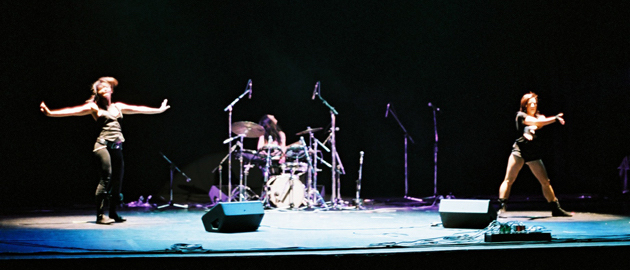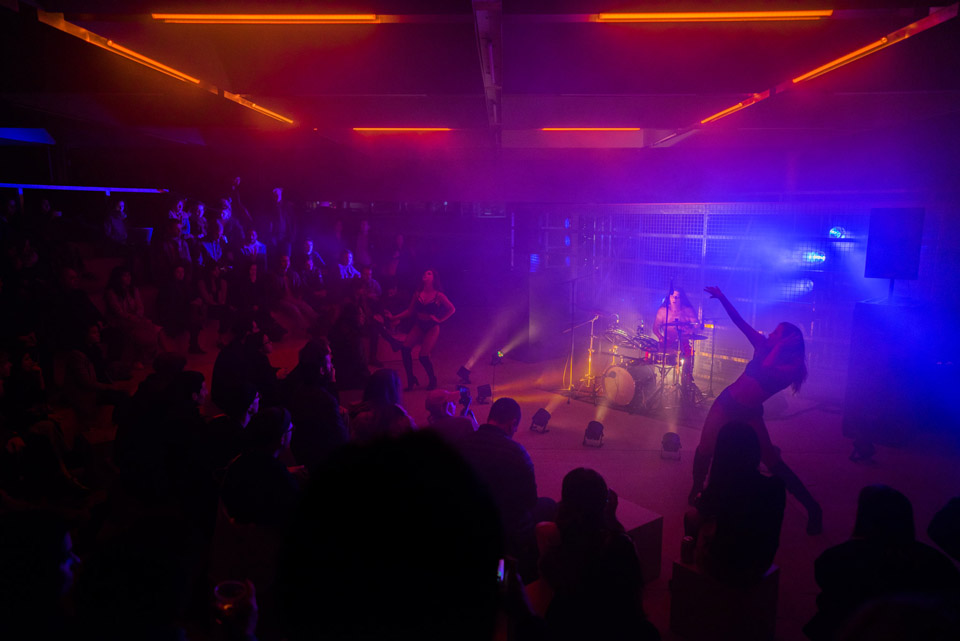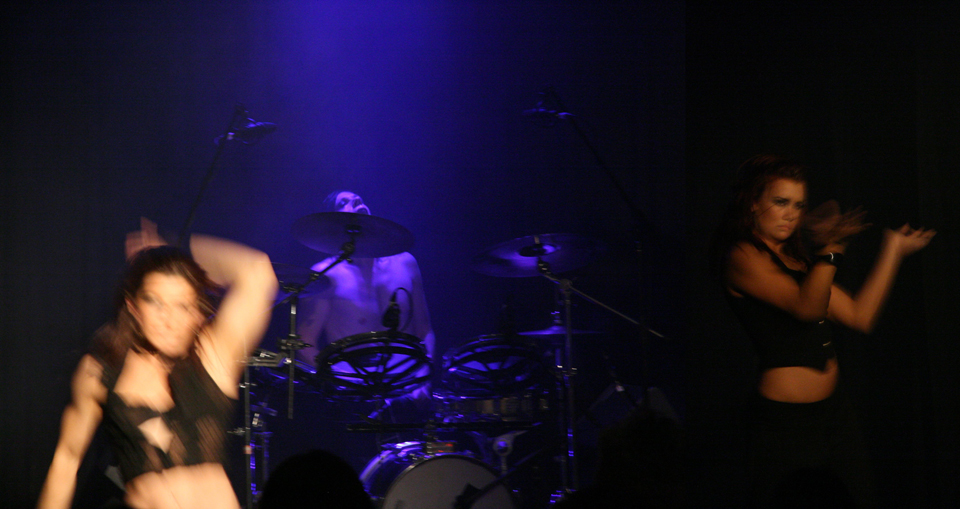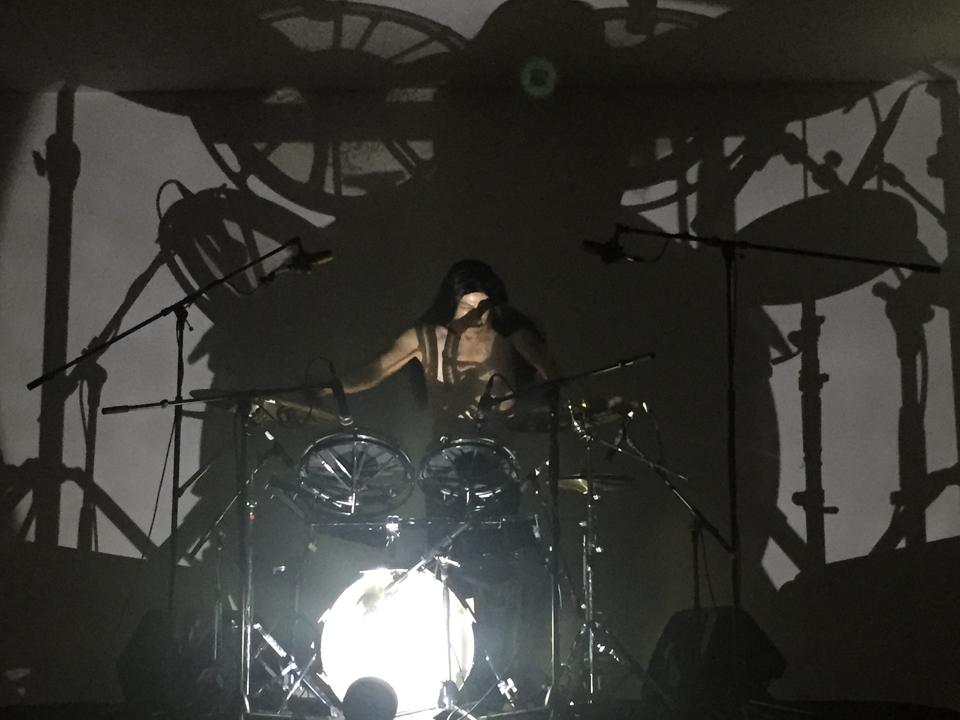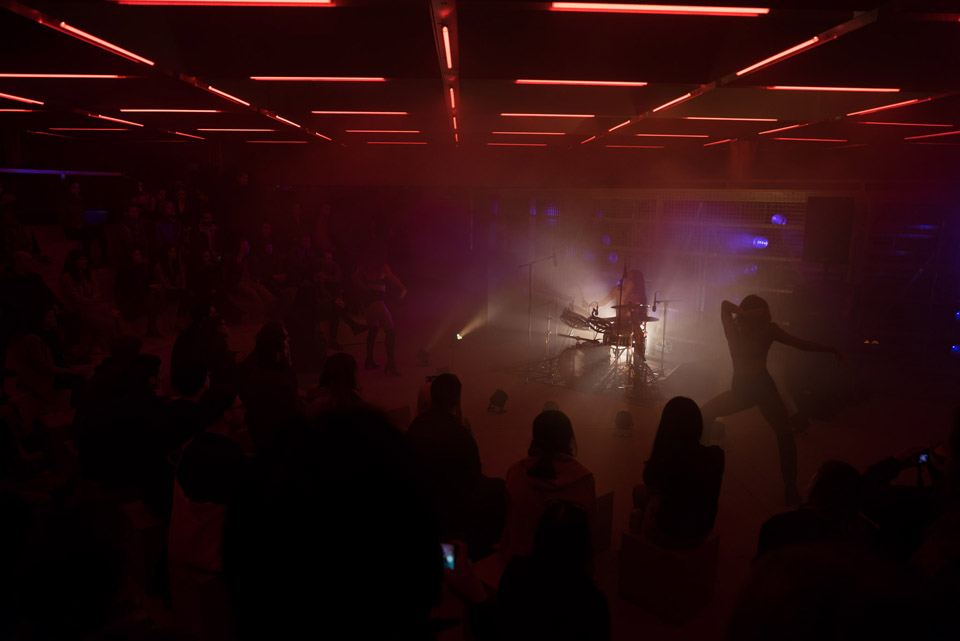Background
Stadium is a live music performance for solo drums and showgirl dancers. The concept of the piece is to present a quasi-orgiastic celebration of rhythm staged theatrically within the mock pyrotechnica of 'the rock gig'. An almost cartoon-like staging unfolds, with Philip bare-chested and adorned with long flowing black metal-dude hair, flailing away at the drums, flanked by two exuberant explosive dancers. No words. No guitars. No other visible instruments. Just a set of skins sandwiched by skin.
One advance piece from the suite of tracks from Stadium was premiered at UNITED ARTISTS at the Palais Theatre, Melbourne, February 2008; two additional pieces were premiered for the December 10th performance at the Toff, Melbourne (in conjunction with the Centre of Contemporary Photography and the exhibition I THOUGHT I KNEW BUT I WAS WRONG in which was exhibited Evaporated Music 2). A final piece has since been composed. Cover version's of ACDC's Thunderstruck and Yes' Heart Of The Sunrise bring the completed Stadium performance to a 45 minute suite. Following a commission for the 2017 M-Pavilion designed by Rem Koolhaas and David Gianotten of OMA, a special piece has been composed to reflect the 'stadium' circular seating design of the latest M-Pavilion. The piece is titled Neo-Tokyo Terrasound Cosmophopny - a reinterpretation of Yamashigumi's Kaneda theme from Otomo Katsuhiro's Akira (1988).
M-Pavilion, Melbourne 2017 © 2017 - photo by John BettsCredits
Live drums & pre-recorded synths - Philip Brophy
Dancers - Haley & Julie (Palais) Haley & Sam (Toff)
Technical assistance - Chris MacKellar (Palais,) Marco Fusinato (Toff), Cal Lyall (Super Deluxe), Atticus Bastow (Neon Parc) & Byron Scullin (M-Pavilion)
Make-up - Bambi & Renae & Bernadette Brophy
Production assistance - Lara Travis (Palais)
2017
M-Pavilion, Melbourne
2016
Neon Parc gallery, Melbourne
2015
Super Deluxe, Tokyo (organised by Jolt Arts)
ReRecords, Hong Kong (organised by Jolt Arts)
LMA, Macau (organised by Jolt Arts)
2012
EXTREMITIES, Super Deluxe, Tokyo (organised by Jolt Arts)
SEXES (opening night), Performance Space, Sydney
ADELAIDE FESTIVAL Barrio, Adelaide
2008
YOU DON'T HAVE TO CALL IT MUSIC, The Toff, Melbourne (in conjunction with the CCP)
UNITED ARTISTS, Palais Theatre (organised by Linden Arts)
Overview
Stadium is named after the most bloated spectacular phase of rock music - 'stadium rock'. Tagged as such in the early to mid 70s (though now sometimes referred to as 'arena rock'), it signalled a time when rock was morphing into a corpulent pre-obese monster of consumption and production. 'Stadium' referred specifically to the new venues rock acts commandeered for their shows. Touring acts like The Who, Led Zeppelin, The Rolling Stones, Queen, Wings, Pink Floyd, Yes, Supertramp, Kansas, Styx, and numerous others gained wide popularity in the US during the early 70s largely through FM radio exposure and its attendant national promotional power. US tours became less regional affairs and more national strategies closely aligned to the corporate logistics and exploitation of the major record labels. While this is the norm now, back then it was an eruption of sorts, requiring the bands to no longer play concert halls - let alone clubs - and forcing them into grander stage arenas such as the extant sporting stadiums. This was the moment when rock became as overground as sport.
Rock'n'roll history paints the period like the US media portrays 'the obesity epidemic', picturing the acts and their trappings as gaudy, excessive, debauched, hysterically out-of-control. Not ecstatically out-of-control like Iggy Pop or Kurt Cobain, but high on intimidating power like thundering hammering demigods, bludgeoning audiences into submission. But such negative views are typical of rock purists who simply couldn't hack that rock had become supremely overground, and so commercially implicated that the countercultural distinction between 'rock' and 'pop' had become meaningless. Furthermore, that very meaningless allowed the rock stage spectaculars of the time to initiate the transformation of rock from a socially-impelled discourse suited to English Lit students, to a bombastic parasympathetic stellar event suited to anyone. The archetypical rock event thus framed itself as loud, throbbing, flashing, doom-laden, apocalyptic, visceral, transcendental - all qualified through vulgar broad-stroked rendering in its staging and presentation that would eventually achieve sublime comic-book form through acts like Kiss.
Stadium is an openly deluded revelling and wallowing in this particular kind of flatulence which makes rock such a fattened overripe display. A parody of the skinny drummer at the back of any stadium act, Philip channels the large scale dramatics of this era which elevated rock to its most bloated stage. Like the rider for Queen. Like the mics surrounding Keith Moon. Like Rick Wakeman's cape. Like Styx's twin-necked guitars. Like Kiss without their make-up.
Neon Parc, Melbourne 2016 © 2016 - photo by Emile ZileTechnical
Stadium involves live drums (with Roto-Toms) played to a backing track of bass synths and swirling keyboard overlays. Lots of phase-shifting and fuzz-wah envelopes. The synthesizers add a pseudoscientific trippy aspect reminiscent of motorik kraut-rock. The build-ups of each track invoke large-scale demented-drama. In honour of the prog end of stadium rock, Druid time signatures are used (eg. 5/4,9/4, etc.).
The dancers are in the showgirl vein: erotic, muscular, pulsating flames of flesh.
Philip is made up as an incarnate sprite of fetid rock: long-haired, white faced, blackened teeth, glittered chest, and track pants revealing a modest line of pubic hair. Tommy Lee doing Butoh versions of Carl Palmer covering AC/DC by way of Jeff Mills.
M-Pavilion, Melbourne 2017 © 2017 - photo by John Betts

